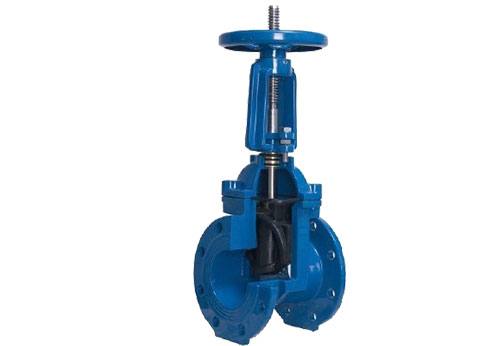Structure of rising stem gate valve
Posted by Bundor valve
Rising stem gate valve: The stem nut is on the bonnet or bracket. When opening and closing the gate, the stem nut is rotated to realize the lifting and lowering of the valve stem. This structure is beneficial to the lubrication of the valve stem, and the degree of opening and closing is obvious, so it is widely used.

Usually, there are trapezoidal threads on the lift rod. Through the nut at the top of the valve and the guide groove on the valve body, the rotary motion is changed into a linear motion, that is, the operating torque is changed into an operating thrust. The opening and closing part of the gate valve is the gate, and the movement direction of the gate is perpendicular to the direction of the fluid. The gate valve can only be fully opened and fully closed, and cannot be adjusted or throttled.
Types of Rising Stem Gate Valves
According to the sealing surface configuration, it can be divided into wedge gate valve and parallel gate valve; wedge gate valve can be divided into: single gate, double gate and elastic gate; parallel gate valve can be divided into single gate and double gate type.
Working principle of rising stem gate valve
Turning the handwheel, through the advance and retreat of the thread of the handwheel and the valve stem, lifts or lowers the valve plate connected with the valve stem to achieve the function of opening and closing. When the rising stem gate valve is closed, the sealing surface can only rely on the medium pressure to seal, that is, only relying on the medium pressure to press the sealing surface of the gate to the valve seat on the other side to ensure the sealing of the sealing surface, which is self-sealing. Most gate valves are forcibly sealed, that is, when the valve is closed, the gate must be forced against the valve seat by external force to ensure the tightness of the sealing surface.
When the valve is opened, when the lift height of the gate is equal to 1:1 times the diameter of the valve, the fluid channel is completely unobstructed, but this position cannot be monitored during operation. In actual use, the apex of the valve stem is used as a sign, that is, the position where it cannot be opened, as its fully open position. Therefore, the fully open position of the valve is determined according to the position (ie stroke) of the gate.

Usually, there are trapezoidal threads on the lift rod. Through the nut at the top of the valve and the guide groove on the valve body, the rotary motion is changed into a linear motion, that is, the operating torque is changed into an operating thrust. The opening and closing part of the gate valve is the gate, and the movement direction of the gate is perpendicular to the direction of the fluid. The gate valve can only be fully opened and fully closed, and cannot be adjusted or throttled.
Types of Rising Stem Gate Valves
According to the sealing surface configuration, it can be divided into wedge gate valve and parallel gate valve; wedge gate valve can be divided into: single gate, double gate and elastic gate; parallel gate valve can be divided into single gate and double gate type.
Working principle of rising stem gate valve
Turning the handwheel, through the advance and retreat of the thread of the handwheel and the valve stem, lifts or lowers the valve plate connected with the valve stem to achieve the function of opening and closing. When the rising stem gate valve is closed, the sealing surface can only rely on the medium pressure to seal, that is, only relying on the medium pressure to press the sealing surface of the gate to the valve seat on the other side to ensure the sealing of the sealing surface, which is self-sealing. Most gate valves are forcibly sealed, that is, when the valve is closed, the gate must be forced against the valve seat by external force to ensure the tightness of the sealing surface.
When the valve is opened, when the lift height of the gate is equal to 1:1 times the diameter of the valve, the fluid channel is completely unobstructed, but this position cannot be monitored during operation. In actual use, the apex of the valve stem is used as a sign, that is, the position where it cannot be opened, as its fully open position. Therefore, the fully open position of the valve is determined according to the position (ie stroke) of the gate.
 简体中文
简体中文 Русский
Русский Español
Español Bundor - Butterfly, Gate, Check, Ball, Globe Valve Manufacturer, Supplier & Distributor
Bundor - Butterfly, Gate, Check, Ball, Globe Valve Manufacturer, Supplier & Distributor
